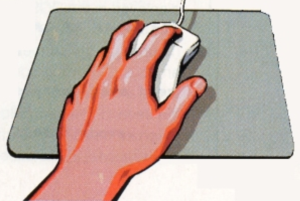
 |
Reveal A Picture |
Click and drag mouse control can be a difficult skill to master, even for adults. This game will help children to understand the relationship between pressing the mouse button, moving the mouse and the pointer moving on the screen.
On entering the game the background appears white with grey question marks. The pointer has become a white arrow over a large black circle. To reveal the hidden picture, click and drag the circle around the screen. The circle will "rub in" part of a larger picture as it is moved. The whole picture will be revealed when most of it has been uncovered.
To move onto the next puzzle, click the left mouse button anywhere on the screen.
The active circle will become smaller as children progress through the activities, thus gradually refining their mouse control.
Sound can be turned off and on by clicking the music symbol in the lower right hand corner.
To Exit, click on the small hand in the lower right corner of the screen.
You may notice that as children's mouse control improves, they will move the mouse faster. In this game this will not solve the puzzles any quicker, as the circle misses parts of the screen. To help, ask children to slow down their mouse movement a little. This will also help to improve their accuracy.
Outcome 1: Children have a strong sense of identity
Outcome 4: Children are involved and confident learners
Outcome 5: Children are effective communicators
Click and drag mouse control
Refining mouse accuracy
Hand-eye coordination
Concentration
Observation skills
"Click and drag" (also drag and drop) can be defined as pressing and holding down the principle mouse button, then moving the mouse without releasing. Click and drag mouse control can be a difficult task to learn for both young children and adults. Like riding a bike, once it has been mastered it is skill for life.
When beginning to learn this skill it very important to have correct posture whilst sitting at the computer and use correct hand positioning on the mouse. Refer to previous teacher tips in the Mouse Movement and Mouse Clicking activities. The user must be comfortable with little to distract them from the task at hand.
Young children may need to be reminded to continually hold down the left mouse button whilst moving the mouse. In this activity the actual action of the circle not moving when the mouse button is not depressed is reminder enough.
Preschoolers sometimes show a tendency to "have a go" using both hands on the mouse. It may take them a while to figure out which one they prefer. If they are not sure but do not show a definite adeptness with a particular side, we recommend that the right hand is encouraged. We also recommend the use of mice that are "universal". They are symmetrical and both left and right-handers can use them. See the diagram below.

Most children are adaptable and happy to use their right hand even if they are left-handed. We have seen a few preschoolers who are so strongly left handed that they find it difficult to use the right.
If a child wants to use their left hand we can help them position their fingers correctly. They will be using the middle finger on the left mouse button and the index finger will rest on the right mouse button. In this case the middle finger is used to click. We have also known left-handers who like to use their index finger for both left and right mouse buttons. This simply needs the hand to be a little more angled on the mouse. Really, in the end it comes down to doing what is most comfortable.
One of the main reasons we don't recommend left handed mice is that the majority of mice likely to be encountered will be universal or right oriented. Mice at pre school, school and elsewhere will most likely not be those designed for left-handers. It is better to teach children how to cope with, and adapt to, hardware that they are likely to encounter.

Left-handers quickly learn to adjust their hand positioning to use a mouse. With preschoolers it may take a little experimentation to discover with which method they are most comfortable.